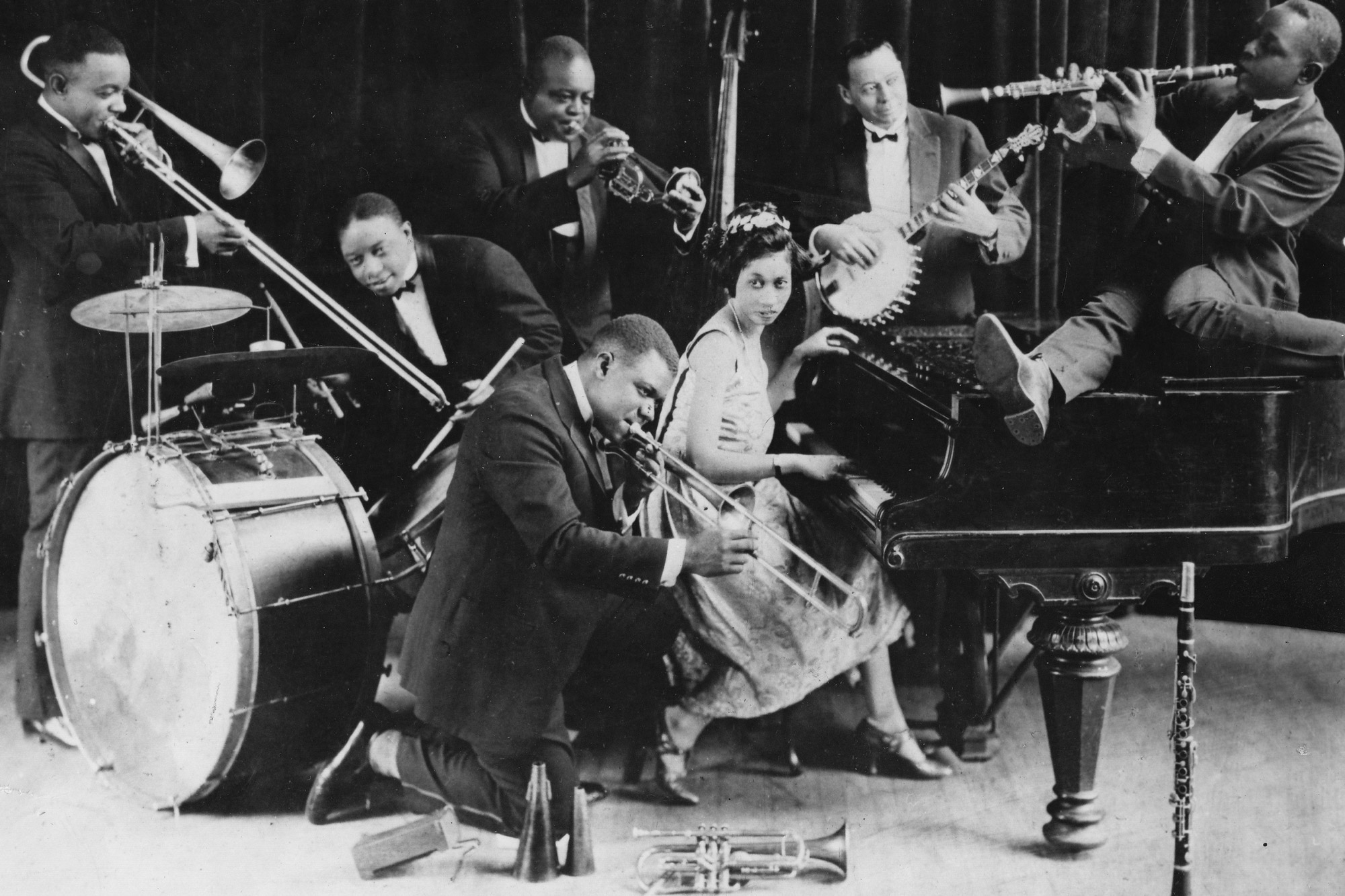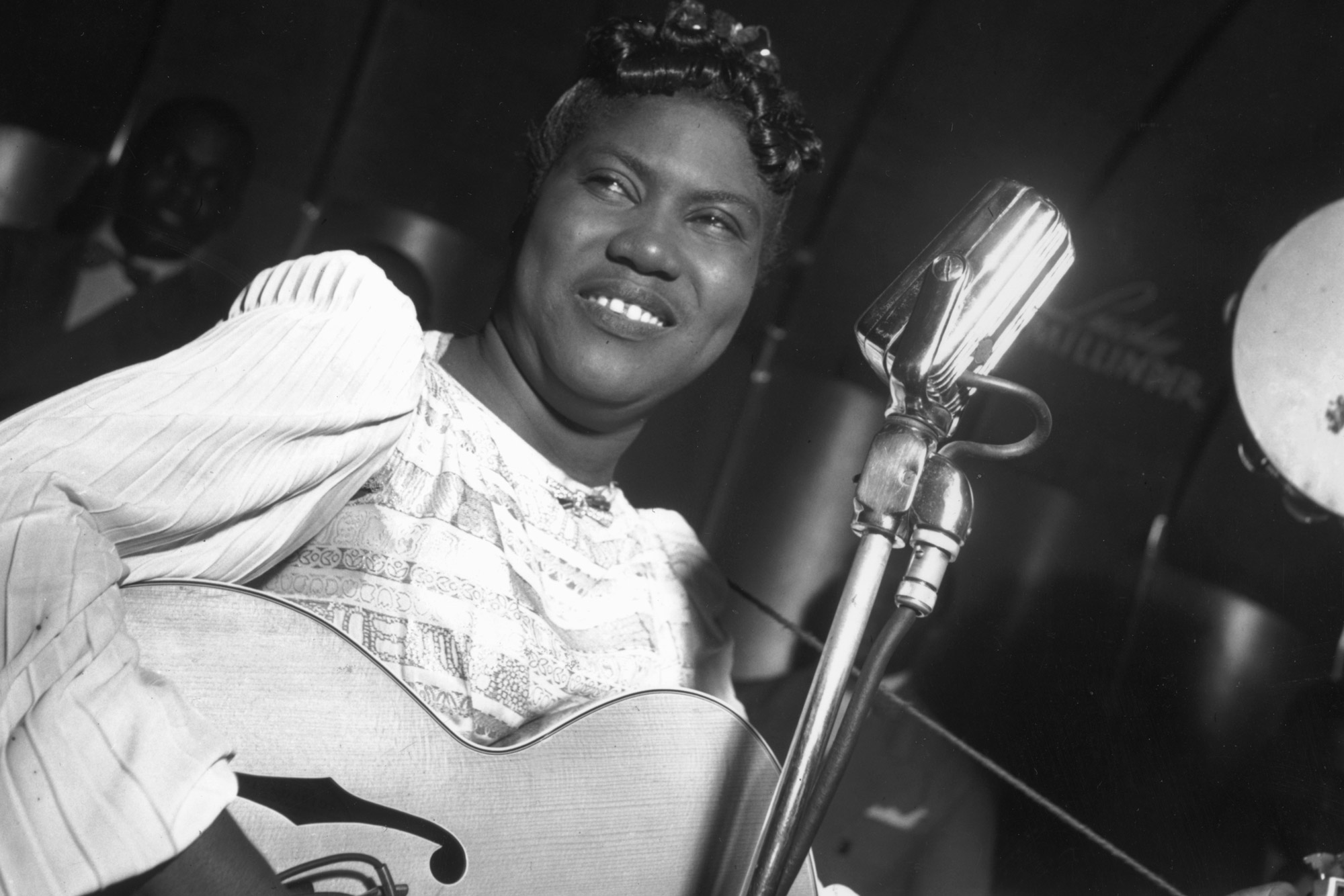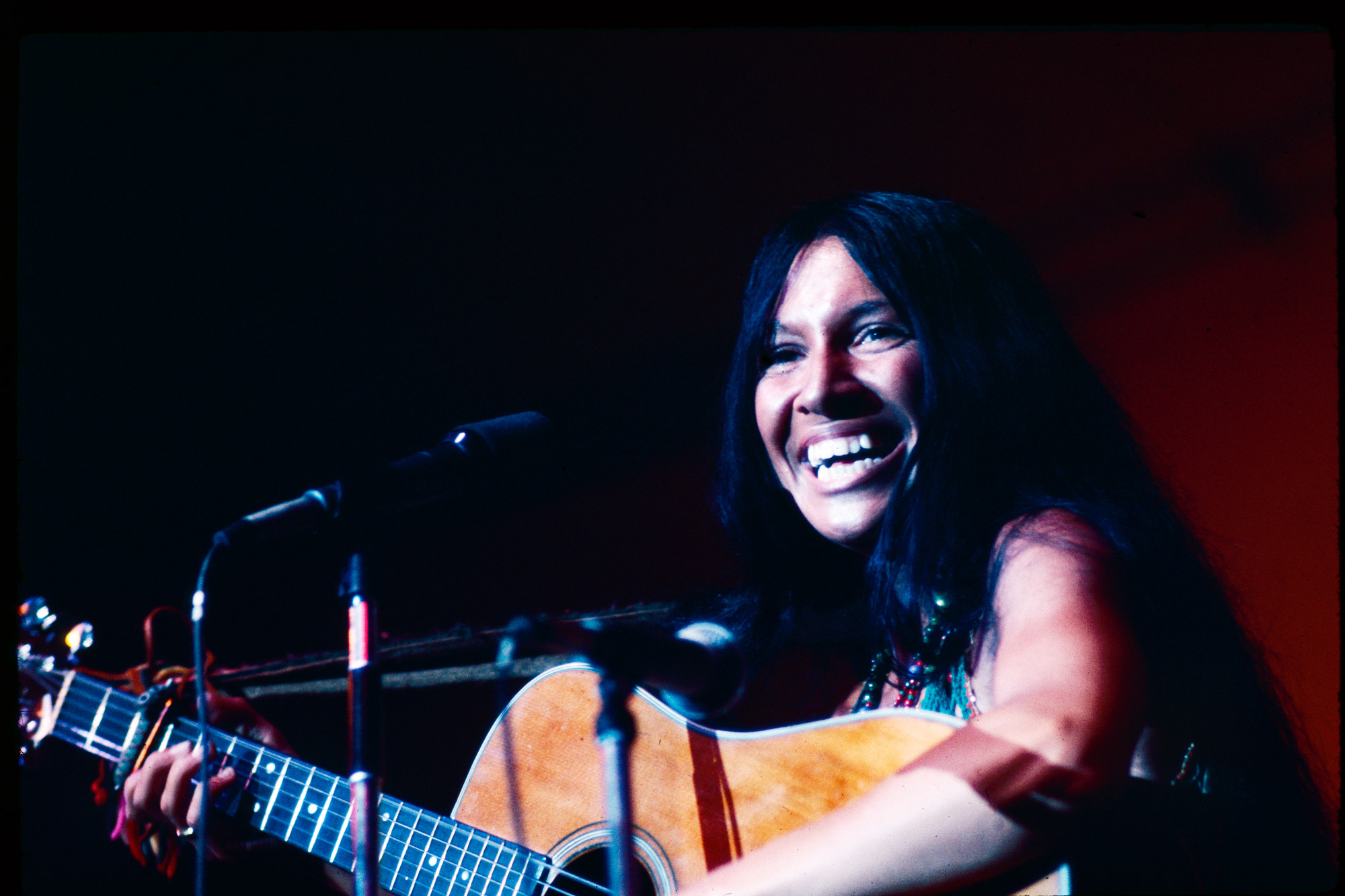Play it again, Samantha
Three pioneering women in three very different eras stand out for having broken down barriers in the male-dominated music industry.
Author:
9 March 2022

Looking back over the golden years of jazz from the 1920s to the 1950s, there was a great choir of female voices. But how many female instrumentalists and songwriters were widely known and celebrated?
There were notable exceptions: pianist, singer, composer and bandleader Lil Hardin was the person largely responsible for Louis Armstong’s successful career. It is perhaps indicative of the sexism of the time that Hardin was better known as Satchmo’s second wife, that she was nicknamed “Hot Miss Lil” and played keyboard “like a man, while dressed like a Sunday school teacher”, according to her biographer.
She wasn’t the only one of these undersung heroines. Mary Lou Williams was described with reason as “one of the foremost swing pianists of either sex”. She wrote hundreds of compositions, recorded more than 100 records and created music over five decades. Duke Ellington famously described her as “perpetually contemporary”.

Trombonist Melba Liston was celebrated by National Public Radio in the United States as a “jazz pioneer” and “one of the few women to succeed as both a jazz instrumentalist and an arranger”. During the 1940s to 1960s she played trombone in the big bands of Gerald Wilson, Dizzy Gillespie, Quincy Jones and Clark Terry.
Also worth mentioning was alto saxophonist Vi Redd, who was a leading figure on the Los Angeles jazz scene during the 1950s. Some of this “passionate bop-based altoist and exciting singer’s” musical associates included Max Roach, Dizzy Gillespie and Count Basie.
But most blues and jazz women – including Ma Rainey, Bessie Smith, Sarah Vaughan, Ella Fitzgerald, Billie Holiday, Big Mama Thornton, Dinah Washington, Cleo Laine – made their names as chanteuses.
Gendered instruments
Gender stereotyping has critically shaped musical performance: noisy instruments, and ones that demand lung power or testosterone-charged “strut” – trumpet, trombone, drums and electric guitar, for example – have tended to become culturally “masculine”.
In Europe’s upper-class households, women entertained on the harp, lute and clavichord, considered fitting for soft hands and pastel emotions.
Coupled with the gendering of instruments have been restrictions on female stage performance. Women were only gradually drawn into choral singing in Europe, for example, and until the 19th century were generally barred from the opera stage, while castrati sang the upper parts.
In early jazz, homosociality – same-sex bonding through friendship and mentorship – was a further barrier. Musical techniques were transmitted through all-male groups with women mainly fronting as vocalists.

The tectonic shift came in 20th century America through the creation, via radio and the fledgling record industry, of an insatiable, ever-changing mass market for popular music. The “race market” exploded in the 1920s and 1930s, becoming a vehicle for Black women who lacked formal training but had the raw musical talent to capture an audience.
It was from early gospel, not jazz, that the first female electric guitarist of real stature and influence emerged. “Sister” Rosetta Tharpe was the child of cotton pickers from backwoods Arkansas, whose mother became a travelling evangelist in the Church of God in Christ. Tharpe first held a guitar as a six-year-old, when her mother would place her on the lid of the piano with the instrument in her hands and make her sing at church and revival meetings.
After signing with Decca in 1938, she became gospel’s first recording superstar, bringing her powerful rendering of sacred songs to hundreds of thousands of Black Christians across the US. What made her sound unique was her groundbreaking use of the electric guitar, thought to have been invented in 1936 by Benny Goodman band member Charlie Christian, who hooked a pick-up to his acoustic instrument to play solos.
Moving on
It was a time of immense demographic upheavals, as a stream of Black migrants abandoned the broken agricultural economy of the South and its Jim Crow laws for northern industry. With her mother, Tharpe moved to Chicago and then New York, and her picking style mirrored their wanderings. Using a thumb pick and her index finger on an open tuning, she combined the single-note licks and semi-chords of the country blues with the electric amplification of Chicago’s urban sound.
Her high-energy, foot-stomping style would feed into rock ‘n’ roll, whose early stars, including Elvis Presley, knew and copied it. Chuck Berry said his whole career “was one long impersonation of Rosetta Tharpe”. “When you see early Elvis, imagine he’s channelling Sister Rosetta,” remarked her biographer, Gayle Wald. “When we think of rock ’n’ roll history, we don’t think about the Black women behind the white men.”
To breach a male fortress Tharpe needed a large, charismatic personality and broad streak of defiant independence – Bob Dylan described her as “a big, good-lookin’ woman and divine, not to say sublime and splendid. She was a force of nature.”
In the late 1930s, to the chagrin of her followers, she signed a seven-year contract to play “the devil’s music” to well-heeled, thrill-seeking whites at the Cotton Club in Harlem in New York. Swing Low Sweet Chariot gave way to Four Five Times – which was not about the frequency of her church visits (He’s my king/ he lets me sing/ four five times). Seamlessly replacing her love of Jesus was her desire for a Tall, Skinny Papa, in a notorious 78-rpm single that scandalised her gospel fan base.
She crossed other boundaries. At a time of still rigid social segregation of the races, she toured with The Jordanaires – an all-white, all-male, close-harmony gospel combo who sang background for Elvis – in a bus with her name emblazoned on the side. Marrying three times, she abandoned her first two husbands because, according to a friend, they viewed her as a “meal ticket”. She is also thought to have had a lesbian lover, her partner in song, Marie Knight.
The “godmother of rock ‘n’ roll” helped ignite the British blues boom of the 1960s, paving the way for the new hard-edged, Chicago-driven guitar rock of Eric Clapton and the Rolling Stones. Invited to tour the United Kingdom in 1964 by English jazzman Chris Barber, she became an instant celebrity. In a glorious video that survives from her visit, she dazzles a crowd of young Britons at a rainy, disused railway station after alighting from a horse-drawn surrey straight out of the musical Oklahoma!.
Rock ‘n’ roll borrowed more than Tharpe’s seminal guitar style – after the long dominance of jazz, with its limited emotional palette, it also incorporated the intense feeling of her gospel vocals. One need not be Christian to be moved by her singing of gospel standard Precious Lord at her last concert, in Copenhagen, when she was already suffering from the disease that would kill her.
Tharpe was a brilliant interpreter of traditional songs and other people’s material. It would take a while longer, until the 1960s, for the female singer-songwriter to emerge as a potent force in popular music.
Zeitgeist of love, freedom and politics
The landmark year was 1971 when Carole King’s quadruple Grammy award-winning album Tapestry and Joni Mitchell’s Blue, ranked the third best album of all time by Rolling Stone, were released. But the trail had been blazed earlier by a group of guitar- or keyboard-playing female musicians who were integral to the 1960s zeitgeist of love, freedom and anti-establishment politics: Nina Simone, Joan Baez, Judy Collins, Odetta – and Buffy Sainte-Marie.
Inflamed by the Vietnam War and the draft, the mood of young people was rebellious and rule-breaking. A wave of un-American ideas swept the country, challenging its possessive individualism and foreign military adventures. Popular music grew out of and shaped the new climate. Gone were the tired formulas of Tin Pan Alley (“Maybe tonight he’ll hold me tight/ when the moonbeams shine” – Doris Day). Liberation, both personal and political, and emotional conviction were the new imperatives.
A brilliantly versatile songwriter, Sainte-Marie’s protest ballads were deeply personal and sung with such ferocious passion that some found her live performances disconcerting. Now in her eighties, she is no longer well known outside Canada, where she was born of Cree parents on the Piapot Reserve in Saskatchewan, orphaned as a child and adopted by an American family.

But she has 20 albums to her name as well as an Oscar (as co-composer of the song Up Where We Belong from An Officer and a Gentleman), a Golden Globe and a string of Canadian awards. Close to 150 artists have covered her classic love lyric Until it’s Time for You to Go, which celebrated the 1960s radical ideal of non-possessive love.
A prominent figure in the Greenwich Village folk scene, Sainte-Marie catalysed the songwriting of fellow Canadian Joni Mitchell, who as a musical trio travelled to the Mariposa Folk Festival in Ontario to hear her. Mitchell’s taste for unconventional guitar tunings – she employs more than 40 of them – is said to have been inspired by Sainte-Marie, whose debut album abounds with tonal experiments.
She put down a marker with the most durable and widely covered antiwar song of the 1960s, The Universal Soldier. In 1966 came Little Wheel Spin and Spin, a menacing incantation about American greed and future-blindness that has lost none of its relevance:
Swing your girl, fiddler say
Later on the piper pay
Do-si-do, swing and sway
Dead will dance on Judgement Day
Sins of birth
But her central theme has been “the genocide basic to this country’s birth” – the destruction of indigenous peoples and continuing seizure of their land. It appears in the lament Now that the Buffalo’s Gone on her first record, triggered by the flooding of the Seneca reservation for the Kinzua Dam in Pennsylvania. In My Country ‘tis of thy People You’re Dying she suggests that America’s true national bird is the carrion crow, rather than the eagle. Her protest songs triggered a years-long blacklisting by US radio.
Increasingly, Sainte-Marie has fused American Indian Movement activism with the environmental mysticism famously associated with Chief Seattle of the Pacific northwest (“All things are connected. Whatever befalls the earth befalls the sons of the earth.”). Her keening tremolo voice, one commentator noted, “could sing the paper slip in a fortune cookie and give it a power drawn from the clouds and the deep energy of rivers”.
Over the years her sound has grown heavier, laden with indigenous drumming, melodic yells and powwow chants, interwoven with power guitar riffs and rock bass figures. Starwalker, a rousing praise-song to Native American survivors, demonstrates her cross-cultural method.
Her 2017 collection of old and new, Medicine Songs, is a monument to a life of musical activism. In No No Keshagesh (an indigenous term for “gutbucket”) she attacks the old enemy – the bankers and pirates in suits. Never afraid to experiment, she has brought the stone-age mouth bow to Western audiences as a live performance instrument.
Her 1969 album Illuminations, on which a Buchla electronic synthesiser was used, is considered the first quadraphonic vocal album ever made. Wire magazine listed it among its “100 Albums that Set the World on Fire When No One Was Listening”.
Typical of its eerie soundscapes and gothic poetry was the song Poppies, in which she invades the dream of her lover “asleep in your summer … while I walk these paths of ice/ ice my breast/ and strings of ice my hair/ My hands two hooks of steel”.
Domain of restless electropop
Half a century later, the interface between music and tech has become the unquestioned domain of restless electropop maestro Imogen Heap, described by one critic as “a mystical force that has loomed over pop music for two decades” and another as “the Nikola Tesla of pop”. With two Grammys, six Tonys and an honorary doctorate on her mantelpiece, Heap is idolised by Ariana Grande and Taylor Swift and has been covered or sampled by Grande, Kendrick Lamar, Kelly Clarkson, Jason Derulo and many others. A musician’s musician, she has become better known through her work in film, theatre and television, including the West End play Harry Potter and the Cursed Child.
As a middle-class Englishwoman classically trained in the clarinet, cello and piano who is not overtly political, Heap appears to have little in common with Tharpe and Sainte-Marie. But like them she is a disruptor and breaker of moulds, seen by many as the future of popular music. She was turning out songs at 13, released her first album, I Megaphone (an anagram of her name), at 21, and at 28 wrote, recorded, produced and mixed the 2005 album, Speak for Yourself, her best.

Heap’s recording studio, which she created in a barn in the English countryside, is a geek’s paradise. She told Sound on Sound magazine that its fixed rack houses the input chain for non-vocal sources and includes a Focusrite Liquid 4Pre preamp, a Line 6 PodXT guitar processor, a TC Helicon Voiceworks Plus vocal processor … the list goes on.
Intrinsic to her unique sonic textures are two bits of digital kit she developed herself, giving the ultimate lie to the notion of women as helpless “songbirds”. Her box of tricks is a virtual instrument with 13 digital capabilities including an array mbira, boom whackers, vibes, glockenspiel, tongue drum, waterphone, whirly tubes and “Euclidean” beats.
Laced with motion sensors, her Mi-Mu gloves are a performance tool that lets her make music on stage without “looking like she’s doing her emails”. By moving her hands in specific ways and blending the movements with her stage act, she can control everything from the phasing of samples to volume, loops, panning and reverb. A typical Heap song combines her wistful, sinuous voice, superimposed on itself, with digital effects to create a multilayered, polyphonic texture. Her lyrics are poetic and intensely inward-looking.
Autobiographical songs
The Listening Chair, from her latest album, Sparks, traces her life in seven-year spans. Starting simply, almost tritely, with her early childhood, it grows edgier and more densely textured as it moves through her unhappy schooldays, with sudden bursts of sunlight. This is pop music for grown-ups, with technology used to enhance feeling.
“Where are we?/ What the hell is going on?” in Hide and Seek is Heap seeing her parents’ separation through the eyes of a disorientated 12-year-old. “Crop circles in the carpet” speak of removed furniture; former family photos leave “oily marks … / where pleasure moments hung before”. The distorted harmonies imparted by the keyboard-controlled digital harmoniser deepen the melancholy.
Heap’s tone paintings, with their dark vein of loneliness and emotional injury, are not to everyone’s taste. But she can get down – Sparks topped Billboard’s electronic-dance chart. The dance track Run-Time displays her jauntier side. Listen, also, to the tender simplicity of the ballad “Speeding Cars”, stripped of its digital ornamentation and backed only by the piano, cello and brushed drums.
With Sparks, Heap unfurls her wings. Discarding the “confining” processes of the traditional album, she released a new song every three months between 2011 and 2013, each with its own video. The result is a daring, if uneven, compilation. Breaking out of her introspective bubble, she draws expansively on other world traditions, such as Indian bhangra and Bhutanese folk and temple music. Different tracks explore different technologies – her Mi-Mu gloves, non-linear “reactive” music and 3-D audio effects. (See the gloves at work on Me the Machine.)
Another experiment, part of Heap’s wider quest for a closer bond with her audience, was the crowdsourcing of both lyrics and sound samples. Uploaded by fans, the 800 “seeds” include doors opening, a cat’s “meow” and rustling leaves.
Pioneering captured
Sainte-Marie’s Starwalker captures the pioneering élan of the three singers:
“Wolf rider, she’s a friend of yours
You’ve seen her opening doors
She’s a history-turner, sweetgrass-burner …”
Each was a “history-turner” who helped force a gateway through which hundreds of women entertainers have passed. Each shaped a global musical movement and its technologies: Tharpe the rock ‘n’ roll revolution, Sainte-Marie the 1960s protest wave and Heap the electronic tonescapes of the new century.
Related article:
Without their challenge to a male industry, women instrumentalists and composers such as the Kenyan Afro-jazz trumpeter Christie Kamau; the first professional female kora player, Sonia Jobarteh of The Gambia; Santana’s drummer Cindy Blackman; and avant pop explorer Lafawndah would have struggled to break in.
But they were not just enablers of other women. They broadened the language of pop beyond “You sigh and the song begins/ You speak and I hear violins” to include politics, faith, sex and the family, and brought to it a new artistic seriousness and concern for emotional truth.

